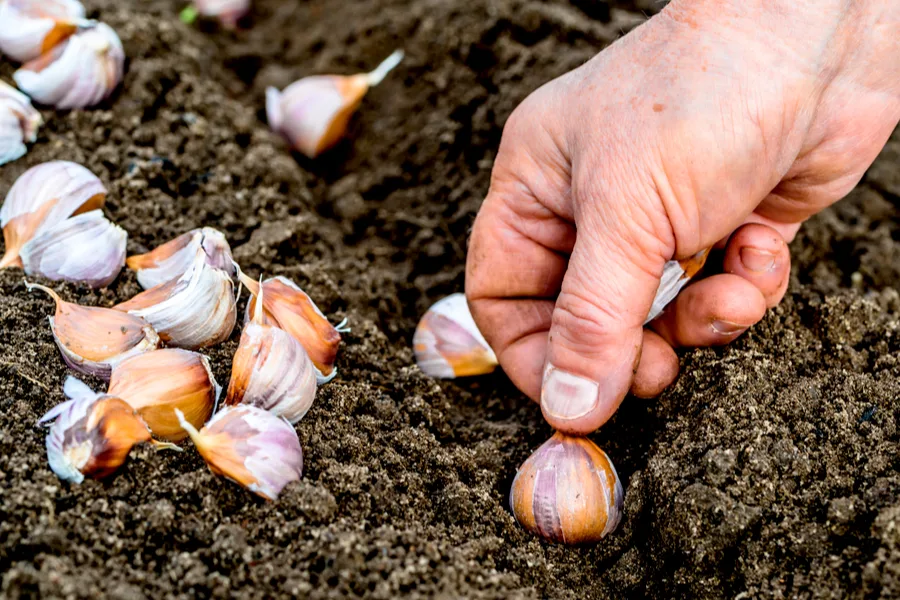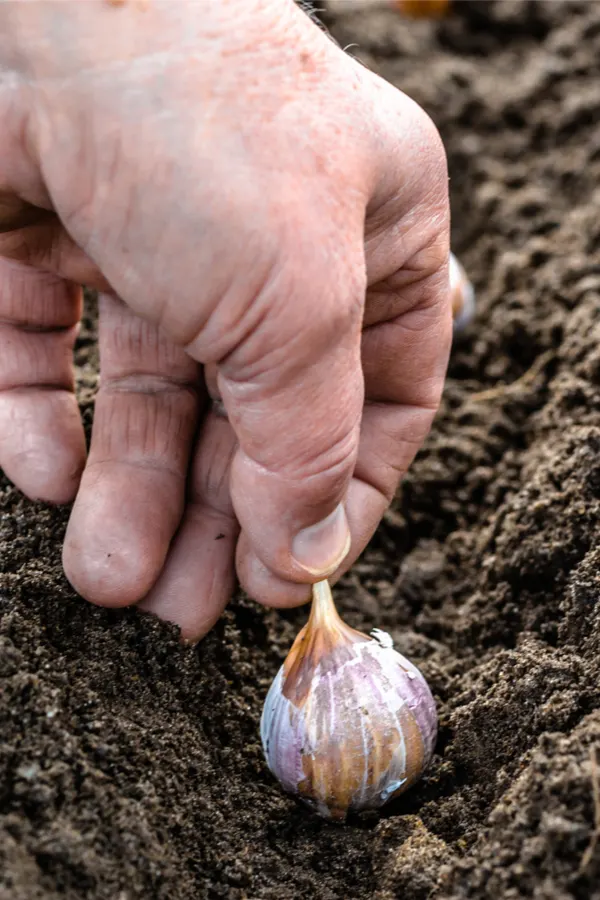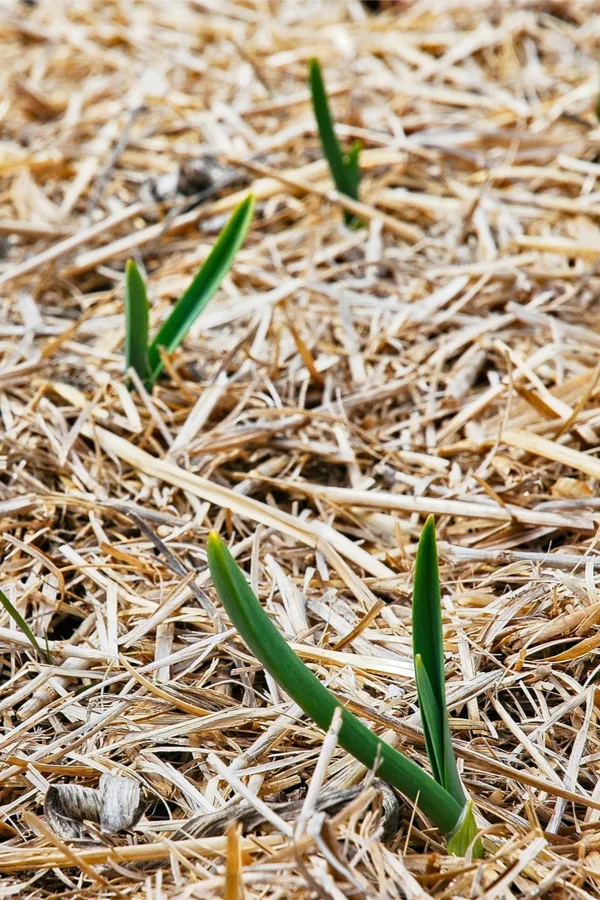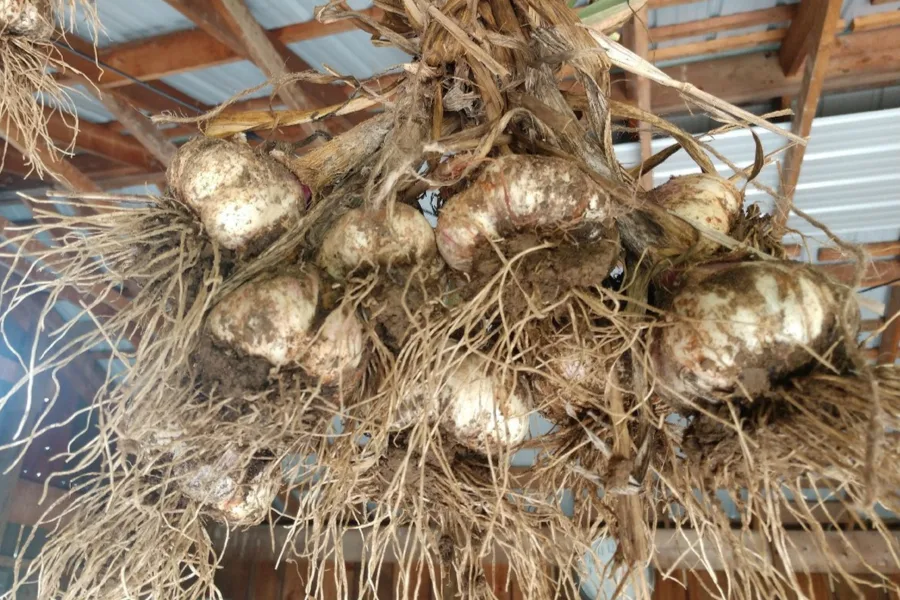When it comes to planting garlic in the fall, a few simple tips will go a long way towards growing an incredible crop that is ready to harvest early next summer.
Garlic is one of our favorite crops of all to grow. In fact, we planted it in the fall in our very first garden some 11 years ago – and have never missed a year planting it since!
But even better, we continue to re-plant the same line of seed from those very first bulbs we pushed into the earth back in 2010. Not only is garlic easy to grow, but it gets better with each passing year as you select the best bulbs to replant from your harvest.

And it is certainly good that it grows so well, because we use it in just about everything! From salsa and pasta sauce, to homemade garlic bread and countless other dishes, we use our homegrown garlic in something nearly every day.
In fact, we even use it to help battle pests naturally outside as well, including a few cloves in our homemade hot pepper spray.
The Ease of Growing Garlic
So what does it take to grow a great crop of garlic? Actually, that may be the best part of all. Garlic is one of the easiest crops to plant and grow in the garden. It naturally repels most pests, and requires little maintenance. It also rarely needs watering or fertilizing.
With that in mind, here is a look at how to plant your own incredible crop this fall, including a short video tutorial near the end as well.
Planting Garlic – The Secrets To Growing A Great Crop
The best time to plant hardneck garlic in the Midwest and Northern states is in the early fall. Here in Ohio, we always plant our crop within the first few weeks of September.

That allows a month or two of cool weather growth for it to become established. It then goes dormant for the winter, and comes back to life in the spring. It is then usually ready for harvesting by late June or the first week of July.
Preparing The Garlic Seed For Planting – Soaking The Seed.
Each single clove of a garlic bulb is an individual seed. Once planted, it will then grow into a full bulb.
We select the largest of our bulbs that we harvest in June to become our “seed” in the fall. Quite simply, the larger the clove, the bigger the mature bulbs will be when you harvest. We grow a variety of garlic called Siberian hardneck. Not only does it grow well, it is excellent for overwinter storage. Product Link : Siberian Hardneck Garlic Cloves

To prepare the cloves for planting, separate each clove carefully. Always be sure to keep as much of the papery skin in tact as possible. The skin serves as a protective layer for the garlic, and keeps it from rotting until it sprouts.
A Little Secret – Pre-Soaking The Bulbs
To help promote sprouting and health, soak your bulbs overnight before planting. Fill a quart jar with water and add in a teaspoon of baking soda. Stir and then drop in the cloves to let them soak.
This soaking not only helps the garlic sprout, but also helps prevent ground rot. Fall can be a wet time in many areas of the country, and a little extra protection against overly wet soils can go a long way for garlic.
Preparing The Soil
Like most vegetables, garlic grows best in fertile, loose soil. Prior to planting, work in generous amounts of compost to help amend the soil.
Compost is the perfect partner for growing garlic. Not only will it help energize the soil with nutrients, it also helps to loosen the dirt to allow for good bulb growth. And just like with all root crops, loose soil can make a big difference between full sized produce, or stunted vegetables.
How To Plant Garlic
Garlic can be planted in traditional rows, raised beds or raised rows. The key is spacing. Bulbs should be spaced 4″ apart within rows and 4″ between rows.

Begin by digging a trench 3 to 4 inches deep. Fill the bottom of the trench with about an inch of compost. As you plant, push each bulb gently down into the compost layer.
We then add in a teaspoon of worm castings around every bulb as we plant. It provides a great source of ready-to-use nutrients for the bulb. Ever since doing this a few years back, our bulbs have been simply amazing! It really is a great little secret to better bulb production.
Plant Up
When planting garlic, make sure to keep the pointy end of each garlic clove up, and the flat end down. The point tip is the sprouting end, and will allow for quick sprouting through the soil.
Finish by covering up the cloves with the remaining soil. Do not press the soil firmly, simply cover by spreading the soil to fill the entire trench level with the surrounding soil.

We place a light 1″ covering of straw over our crop right after it is planted. This protects the ground from weed seeds blowing in, but still allows the garlic to sprout. Once you have put on your light coat of mulch, water the crop in to help the bulbs and mulch settle in.
Mulching For Weed Control & Winter Protection – The Secrets To Planting Garlic
Once the crop has sprouted in the fall, we add a few more inches of additional straw mulch to help protect the crop through winter. You can also use shredded leaves as well, but whatever you do, mulch the crop!
One of the biggest secrets to growing garlic is to keep it from competing with weeds. Weeds compete for nutrients, and a weedy patch will keep yields of your garlic lower, and the bulbs you harvest smaller.

Garlic is a fairly drought resistant crop. Normal rainfall will usually keep it growing well. If you do experience extremely dry conditions for more than 10 to 14 days in the fall, water the crop to help it along.
Spring Maintenance – The Secrets To Planting Garlic
As spring arrives, the garlic crop will come out of dormancy and continue to grow. We usually add a bit more mulch to suppress weeds in the early spring. But other than that, the only maintenance required before harvesting is to keep the weeds out.
So how do you know when garlic is ready for harvesting? Depending on where you live, the harvest times can vary a bit. You will begin to see the tops of the crop begin to brown off in early summer. As soon as two-thirds of the garlic tops have browned off, the crop is ready to harvest and cure.

For us here in east-central Ohio, that is usually the first few weeks of July. It can certainly vary from late June to late July depending on your climate.
Once the garlic is harvested, it needs to cure for a few weeks to dry out and be ready for storage. One thing you do not want to do is wash your crop off! Allow the dirt around the cloves to dry off naturally – water can prematurely rot the crop as it dries.
We hang our crop up in the barn and let it air out. Usually within a few weeks, we can cut the heads off with a bit of the stem and they are ready to store.
Here is to planting and growing your own amazing crop of garlic this fall. Happy Gardening! Jim and Mary.
